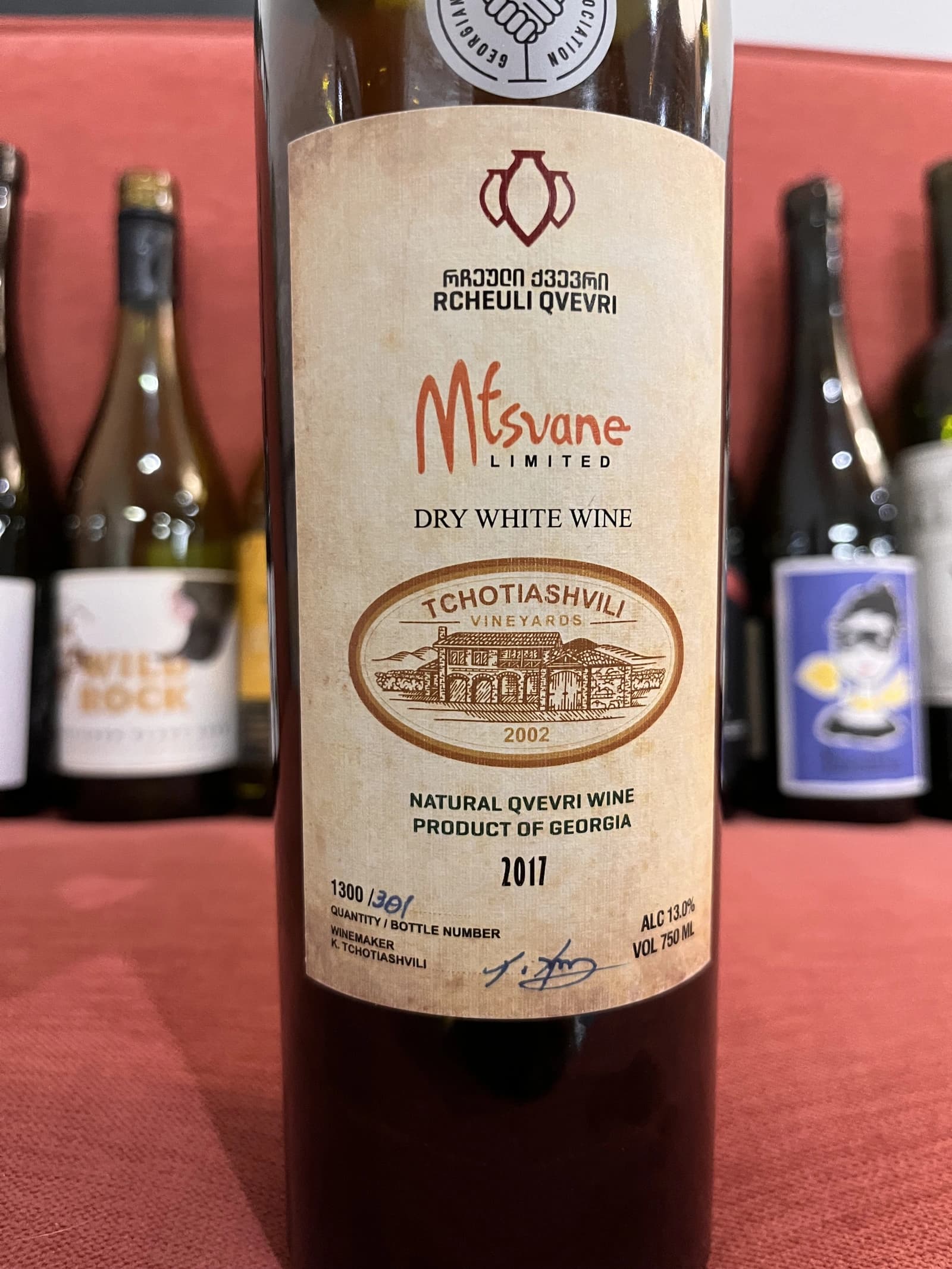Tchotiashvili Mtsvane Rcheuli Qvevri 2017
- Region
- Georgia » Kakhetia
- Type
- white still, dry
- Producer
- Vintage
- 2017
- Grapes
- Mtsvane
- Alcohol
- 13
- Sugar
- 4
- Volume
- 750 mL
- Cellar
- not available

The Tchotiashvili Mtsvane Rcheuli Qvevri 2017 is a splendid showcase of the Mtsvane grape, a variety native to Georgia, and known for its aromatic complexity and depth. This wine is crafted using the traditional Kakhetian method, undergoing an 8-month maceration period on full grape skins, pips, and stems in Qvevri. Such an extensive maceration process allows the wine to extract a wide array of flavours and tannins from the grape components, resulting in a wine with a rich texture and profound character.
Grown in the Inner Kakheti region, on the left bank of the Alazani River at the foot of the Caucasus Mountains, the Mtsvane grapes come from vines planted in 1980. The soil's light, sandy nature, rich in Cordier-carbonate, contributes to the wine's distinctive profile. The wine is bottled without filtration, and minimal sulfites are used only for Qvevri disinfection, adhering to the winery's philosophy of natural winemaking. The Mtsvane Rcheuli Qvevri 2017 offers a unique tasting experience, reflecting the terroir's influence and the winery's dedication to preserving and celebrating Georgian winemaking traditions.
Ratings
This wine melds apricot jam, peach-flavored ice tea, and unexpected hints of pencil shavings and cranberry (yes, really!). A dash of tangerine zest adds to its charm. It's relatively fresh, well-structured with well-integrated tannins (although punchy), creating a delicious experience. While it stands well on its own, pairing it with a spread of Georgian cuisine could elevate it to new heights.
About Producer
The Tchotiashvili winery, steeped in history and tradition, has its roots deeply embedded in the Alazani Valley of Georgia, a region renowned for its rich viticultural heritage. Dating back to the early 18th century, the Tchotiashvili family has been engaged in winemaking for over six generations, demonstrating a steadfast commitment to the ancient art of wine production. The family's ancestral home in the village of Saniore, beside the Lopota River, has been the epicentre of their winemaking journey, where they have traditionally harvested grapes and crafted wine in Qvevri - large earthenware vessels used for fermentation, storage, and ageing.
Kakha and Ucha Tchotiashvili, the current custodians of the family business, continue to uphold these time-honoured traditions. Kakha, the winemaker and technologist, has blended inherited wisdom with modern scientific methods and experimental approaches to viticulture and oenology. In 2002, the brothers expanded their vineyards to include rare grape varieties, creating experimental ampelographic sections that have become instrumental in their winemaking evolution.
2013 marked a significant milestone for the family, as they transformed their business into a small yet promising company, "Satsnakheli". This transition allowed them to introduce their traditionally made Qvevri wines to a broader market. The Tchotiashvili family's dedication to wine production encompasses everything from meticulous soil care to the final bottling process, with each family member actively participating in every stage. The wines are only released after thorough inspection and approval by Kakha, ensuring the highest quality standards.
Their relentless pursuit of excellence and love for their craft have earned Tchotiashvili wines high acclaim and numerous awards at various international exhibitions. This recognition is a testament to their tireless work, deep-rooted love for winemaking, and a strong sense of responsibility towards maintaining and elevating the family legacy.
Vineyards and Cellar
The Tchotiashvili vineyards are scenically situated on the slopes of the Caucasus Mountains, near the rivers Lopota and Stori in the Kakheti region, known for its unique microclimate and famed grape varieties like Saperavi and Rkatsiteli. Positioned 420-450 meters above sea level, the vineyards span 12 hectares and cultivate over 40 wine grape varieties. This extensive range includes 12 Georgian varieties like Rkatsiteli, Mtsvane, and Saperavi, as well as European ones such as Montepulciano and Shiraz. The focus on a diverse array of grapes, including those in the experimental ampelographic plot, showcases the winery's commitment to exploring and expanding the potential of Georgian winemaking.
The winery's cellar complex was designed with a deep respect for local cultural and architectural traditions, utilizing old bricks as the primary building material. The complex includes a residential building with an attached cellar, featuring a guest hall, tasting room, and various agricultural and household pantries. Traditional Georgian elements like the "tone" (stove for baking Georgian bread) and a large machine for making grape vodka enhance the authenticity of the experience.
The on-ground cellar houses 22 Kakhetian Qvevri, each with a capacity of approximately 2 tons, alongside traditional devices for Qvevri care and oak barrels. To accommodate growing production and visitor reception, a new production room and warehouse equipped with modern facilities, including an Italian bottling line, were added in 2018. Despite these modern additions, the winery maintains its traditional practices, with manual labelling and hand-sticking of labels on bottles.
In 2019, a new building with an underground cellar was constructed, featuring 23 Qvevri and additional space for the enlarged family. This expansion not only increased their production capacity but also allowed for further experimentation in winemaking techniques, using both Caucasian and French oak barrels for fermentation and ageing.
Winemaking Technology
Georgian winemaking, with its 8,000-year history, is an integral part of the country's culture, and Tchotiashvili is a proud proponent of this rich tradition. The Qvevri method, a hallmark of Georgian winemaking, involves fermenting and ageing wine with grape skins, pips and stems. This process imparts unique flavours, colours, and textures to the wines. The traditional method includes crushing grapes in a winepress, transferring the juice into Qvevri for fermentation, and then adding grape dregs, skins, and pips.
The meticulous process of fermentation and maturation in Qvevri is carefully monitored through laboratory and organoleptic control. The wines undergo a natural evolution in these vessels, acquiring distinct aromas and flavours. After maturation, the wines are bottled and sealed, continuing their development in the bottle, and enhancing their complexity and drinkability over time.